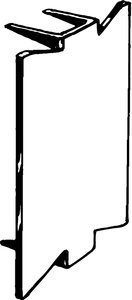Okay, had a meeting with a local contractor and I need to know how you guys feel about this scenario.Hole drilled around 3/4 from face of stud but the wire is toward the back of the hole. The electrician says this type of installation is okay because it meets the intent of the code of being at least 1 1/4 inches from the face of the stud.We brought copies of the section of the code for the last three code cycles where the code specifies the hole for the wire shall be at least 1 1/4 inches from the face of the stud.He still believes this type of installation meets the intent of the code.What is your opinion. We say add a nail plate. Pictures below and two more questions on the same house.
View attachment 1412
View attachment 1413
This is more of a uh huh...sure than anything else.Stress relief on double gang boxes. I saw that there were "stress" marks on the plastic box where the romex was pulled through the box. Electrician said is was due to a faulty product and that when they pull the wires through it was causing the strees marks and then the tabs would not spring back to secure the wire.I said are you sure your not jabbing the screw driver in there and reaming the tabs so it is easier to pull the wires through???? Uhhh no!!! Well then what happened on this box then?View attachment 1416
View attachment 1415
Next....how many wires under a staple???? Electrician says.. he uses S100's...don't know what the pecs are but.....View attachment 1417
View attachment 1412
View attachment 1413
View attachment 1415
View attachment 1416
View attachment 1417
/monthly_2010_10/572953de1fc18_ShadyValleyElectricalFrank005.jpg.89f131380267631c1b854a172b17d774.jpg
/monthly_2010_10/572953de24f1e_ShadyValleyElectricalFrank004.jpg.199a334bf355de26987e1782fea6cf52.jpg
/monthly_2010_10/572953de2eaae_ShadyValleyElectricalFrank008.jpg.2b5c93d94b1b94d563f596fe6a1568aa.jpg
/monthly_2010_10/572953de33c8e_ShadyValleyElectricalFrank002.jpg.6c65a48a08d1a9be0314bda24c43e591.jpg
/monthly_2010_10/572953de38065_ShadyValleyElectricalFrank010.jpg.a436219eae4fe56dc0b94519019b0875.jpg
View attachment 1412
View attachment 1413
This is more of a uh huh...sure than anything else.Stress relief on double gang boxes. I saw that there were "stress" marks on the plastic box where the romex was pulled through the box. Electrician said is was due to a faulty product and that when they pull the wires through it was causing the strees marks and then the tabs would not spring back to secure the wire.I said are you sure your not jabbing the screw driver in there and reaming the tabs so it is easier to pull the wires through???? Uhhh no!!! Well then what happened on this box then?View attachment 1416
View attachment 1415
Next....how many wires under a staple???? Electrician says.. he uses S100's...don't know what the pecs are but.....View attachment 1417
View attachment 1412
View attachment 1413
View attachment 1415
View attachment 1416
View attachment 1417
/monthly_2010_10/572953de1fc18_ShadyValleyElectricalFrank005.jpg.89f131380267631c1b854a172b17d774.jpg
/monthly_2010_10/572953de24f1e_ShadyValleyElectricalFrank004.jpg.199a334bf355de26987e1782fea6cf52.jpg
/monthly_2010_10/572953de2eaae_ShadyValleyElectricalFrank008.jpg.2b5c93d94b1b94d563f596fe6a1568aa.jpg
/monthly_2010_10/572953de33c8e_ShadyValleyElectricalFrank002.jpg.6c65a48a08d1a9be0314bda24c43e591.jpg
/monthly_2010_10/572953de38065_ShadyValleyElectricalFrank010.jpg.a436219eae4fe56dc0b94519019b0875.jpg


